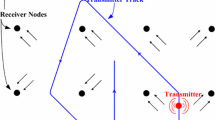Abstract
This paper investigates a new channel gain map tracking by Space-Time Extended Kalman Filtering (STEKF) for a flat channel, and a novel spectrum sensing via Time Spatial Weighted Non-negative Lasso (TSWNL) algorithm. STEKF enables CRs to estimate and interpolate channel gain map for the entire geographical area of interest with a limited number of CRs measurements. In order to sense primary users (PU) activities, include the transmission power by each PU, location and number of active PUs, TSWNL algorithm is proposed. Numerical results illustrate that the proposed STEKF channel estimation and TSWNL sensing algorithms outperforms linear methods.












Similar content being viewed by others
References
Haykin, S. (2005). Cognitive radio: Brain-empowered wireless communications. IEEE Journal on Selcted Areas in Communication, 23, 201–220.
Yucek, T., & Arslan, H. (2009). A survey of spectrum sensing algorithms for cognitive radio applications. IEEE Communications Surveys & Tutorials, 11(1), 116–130.
Zhao, Q., & Swami, A. (2007). A survey of dynamic spectrum access: Signal processing and networking perspectives. In Proc. IEEE Int. Conf. Acoustics, Speech, Signal Process (pp. 1349–1352).
Chen, Q., Motani, M., Wong, W.-C., & Nallanathan, A. (2011). Cooperative spectrum sensing strategies for cognitive radio mesh networks. Selected Topics in Signal Processing, IEEE Journal of, 5(1), 56–67.
Gandetto, M., & Regazzoni, C. (2007). Spectrum sensing: A distributed approach for cognitive terminals. Selected Areas in Communications, IEEE Journal on, 25(3), 546–557.
Ganesan, G., Li, Y., Bing, B., & Li, S. (2008). Spatio-temporal sensing in cognitive radio networks. IEEE Journal on Selected Areas in Communications, 26(1), 5–12.
Mark, B. L., & Nasif, A. O. (2009). Estimation of maximum interference-free transmit power level for opportunistic spectrum access. IEEE Transactions on Wireless Communications, 8(5), 2505–2513.
Tandra, R., Sahai, A., & Mishra, S. M. (2009). What is a spectrum hole and what does it take to recognize one? Proceedings of the IEEE, 97(5), 824–848.
Gezici, S. (2008). A survey on wireless position estimation. Spiringer, Journal of Wireless Personal Communications, 44(3), 263–282.
Rappaport, T. S. (1996). Wireless communications. Principles practice. Englewood Cliffs, NJ: Prentice-Hall.
Poutanen, J., Haneda, K., Kolmonen, V.-M., Salmi, J., & Vainikainen, P. (2009). Analysis of correlated shadow fading in dual-link indoor radio wave propagation. Antennas and Wireless Propagation Letters, IEEE, 8, 1190–1193.
Malmgren, G. (1997). On the performance of single frequency networks in correlated shadow fading. IEEE Transactions on Broadcasting, 43(2), 155–165.
Gudmundson, M. (1991). Correlation model for shadow fading in mobile radio systems. Electronics Letters, 27(23), 2145–2146.
Agrawal, P., & Patwari, N. (2009). Correlated link shadow fading in multi-hop wireless network. IEEE Transactions on Wireless Communications, 8(8), 4024–4036.
Wikle, C. K., & Cressie, N. (1999). A dimension-reduced approach to space-time Kalman filtering. Biometrika, 86(4), 815–829.
Proakis, J.G., & Salehi, M. (1995). Digital communications (Fifth edn). New York: McGraw-Hill.
Anderson, B. D. O., & Moore, J. B. (1979). Optimal filtering. ser. Prentice- Hall information and system sciences series. Englewood Cliffs, NJ: Prentice-Hall.
Bazerque, J.-A., & Giannakis, G. B. (2010). Distributed spectrum sensing for cognitive radio networks by exploiting sparsity. IEEE Transactions on Signal Processing, 58(3), 1847–1862.
Angelosante, D., Bazerque, J.-A. & Giannakis, G. B. (2009). Online coordinate descent for adaptive estimation of sparse signals. In Proc. IEEE Workshop Statist. Signal Process., Cardiff, Wales, U.K. (pp. 369–372).
Suetin, P. K. (1999). Orthogonal polynomials in two variables. Boca Raton, FL: CRC.
Author information
Authors and Affiliations
Corresponding author
Rights and permissions
About this article
Cite this article
Mahboobi, B., Mohammadkarimi, M. & Ardebilipour, M. Spatial-Temporal Cooperative Spectrum Sensing in Flat Fading Channels for Cognitive Radio Using Extend Kalman Filter. Wireless Pers Commun 75, 195–218 (2014). https://doi.org/10.1007/s11277-013-1356-9
Published:
Issue Date:
DOI: https://doi.org/10.1007/s11277-013-1356-9




